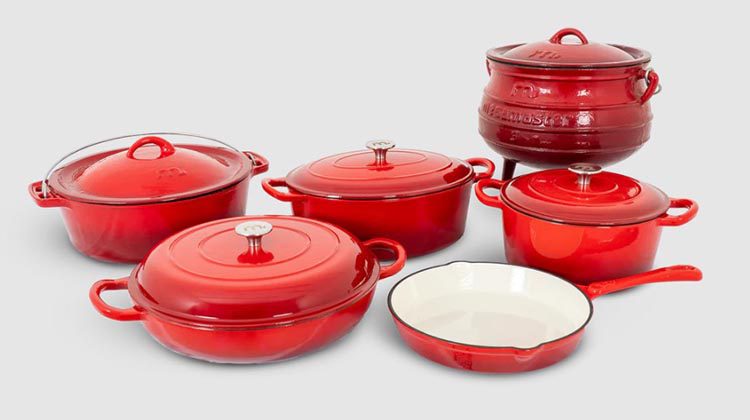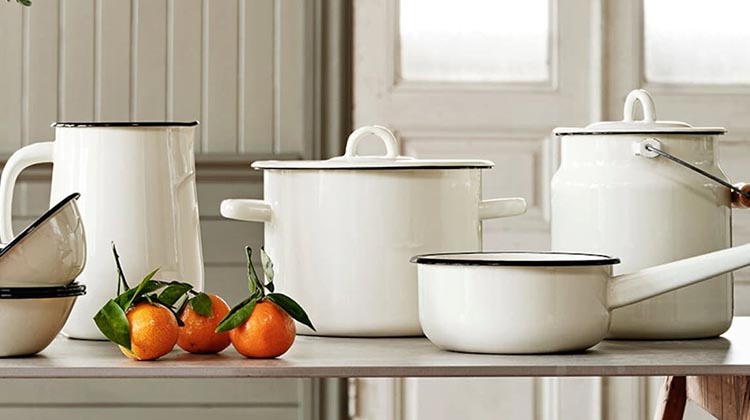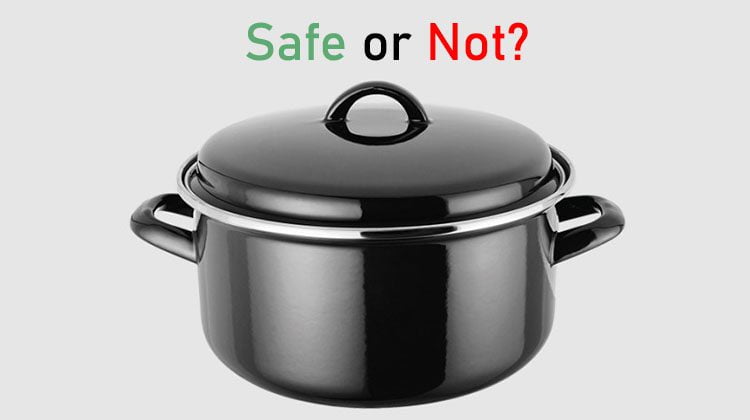Is Enamel Cookware Safe? Comprehensive Guide to choosing best cookware.

Wondering about the safety of enamel cookware? is enamel cookware safe? Yes! Enamel-coated cookware is generally safe for cooking and preparing meals. As a barrier between the metal base and your meal, the enamel coating shields them from any harmful reactions. Because of this, many home cooks favor it.
It is hence a preferred option for many home cooks. However, there are a few things to keep in mind to ensure the safety of using the best enamel cookware. Overheating can cause the enamel to chip or break, which will damage the cookware’s functionality and safety.
Also, while cooking with enamel-coated pots and pans, it’s advised to avoid using metal utensils that could scratch the enamel surface. You may confidently enjoy the advantages of enamel cookware in your kitchen without worrying about its safety by adhering to a few straightforward rules.
What is Enamel Cookware?

Enamel cookware is a type of kitchen pot or pan with a smooth and durable coating made from melted glass. This coating fuses onto a metal base, often cast iron or steel, and creates a protective layer.
Enamel cookware is safe and popular due to its vibrant colors, easy cleaning, and non-reactive nature. The smooth surface helps prevent sticking and allows for even heat distribution.
Cooking with enameled cast iron cookware and enameled pots and pans is simple. Place it on a stove or in an oven like other cookware. The enamel layer prevents rust and corrosion, making it long-lasting. Acidic foods like tomatoes won’t react with the enamel, keeping your dishes safe and tasty.
Cleaning is a breeze as well – usually, a gentle scrub with soapy water is enough. Avoid using harsh cleaners or abrasive materials to maintain the enamel’s integrity. Enamel cookware is versatile; you can use it for sautéing, braising, baking, and more. However, it might chip if dropped or banged.
Related Content:
How To Clean Discolored Enamel Cookware? 5 Easy Ways
What is enamel cookware made of?

Crafters make enamel cookware from a blend of materials, combining the best of both worlds. The foundation is usually cast iron or steel, known for its excellent heat retention and distribution. These metals form the core of the cookware.
The enamel coating, which names the cookware, forms by fusing powdered glass onto the metal surface. This glass layer provides a smooth, protective barrier that prevents the metal from interacting with food and also resists staining.
To create the enamel coating, manufacturers mix finely ground glass with pigments to achieve the desired colors. This mixture is then applied to the metal in layers.
The cookware is then fired at extremely high temperatures, causing the glass particles to melt and form a strong bond with the metal. This firing process also gives the enamel its glossy finish.
Some enamel cookware features additional layers, like a layer of porcelain enamel on the interior for added durability and a smoother cooking surface. This combination of materials results in cookware that is both visually appealing and highly functional.
The enamel coating adds benefits like resistance to rust and corrosion, and it doesn’t react with acidic or alkaline foods, ensuring your dishes taste just as they should. However, it’s important to note that enamel cookware can be susceptible to chipping if subjected to rough handling or drastic temperature changes.
If you’re looking to explore other choices for cookware, you might want to take a look at the Best Hard Anodized Cookware. This can provide you with a unique cooking experience.
Related Content:
10 Best Cookware For Electric Stove And Buying Guide
Is enamel cookware safe?

Enamel cookware is generally safe for cooking when used and cared for properly. Enamel cookware or enamel-coated pots, known for their good choice of stainless steel and non-stick surfaces,
This Non-PTFE PFOA cookware ensures safety, that’s why It’s a safer alternative compared to regular cast iron due to lower levels of lead and cadmium.” Enamel cast iron pot, or enamel cooking pots, offer versatility with the best enamel coating.
So if you think that are enamel pots good or not ? The genuine ans is yes, enamel pots are generally considered good for cooking due to their even heat distribution, non-reactive surface, and versatile usage.
The safety of enamel cookware is attributed to several factors:
- Non-Toxic Materials: Enamel is composed of natural minerals like feldspar, quartz, and clay, which are fused to the metal base through high heat. These materials are non-toxic and safe for food preparation.
- Non-Reactive Surface: Enamel provides a non-reactive cooking surface, which means it won’t react with acidic or alkaline foods. This prevents the transfer of unwanted flavors or chemicals into your meals.
- Even Heat Distribution: Enamel-coated cookware distributes heat evenly, reducing the risk of hot spots that could burn or overcook food.
- Smooth Surface: The smooth enamel surface is easy to clean and less likely to harbor bacteria or food residues compared to rougher surfaces.
- Color Pigments: While some concerns have been raised about the use of color pigments in enamel, reputable manufacturers use food-safe pigments that are stable at cooking temperatures.
However, it’s important to note that enamel cookware does have some limitations. It can chip if dropped or hit against hard surfaces, and it might not tolerate extremely high temperatures. Users should avoid using abrasive cleaners or utensils that could scratch the enamel coating.
Additionally, checking the manufacturer’s instructions for specific care guidelines is essential to maintain the cookware’s safety and longevity, to discover the best Enamel Cookware Set for Your Kitchen.
Related Content:
10 Best Cookware Set Under $100 with Buying Guides, Pros & Cons
How to Clean Enamel Cookware?
Regular maintenance and cleaning enamel cookware is a straightforward process that can extend the lifespan of your cookware and keep it looking great.
Give your enamel cookware a quick wash even if it appears slightly soiled. This prevents the buildup of stains and residues over time. After washing, ensure that the cookware is completely dried before storing it.
Excess moisture can lead to water spots or even rust on the metal portions of the cookware. Here’s more detail on how to clean enamel cookware effectively:
- Allow Cooling: Once you’re done cooking, give the enamel cookware time to cool down. Enamel damage can result from abrupt temperature fluctuations.
-
- Hand Wash: While manufacturers may label some enamel cookware as dishwasher safe, it’s generally recommended to hand wash it to preserve the enamel’s longevity and appearance.
-
- Gentle Scrubbing: With the soaked cookware, use a soft sponge or cloth to scrub away any remaining food particles gently. Or fill the cookware with warm water and add a mild dish soap. Use a soft sponge or cloth to wash the interior and exterior of the cookware.
-
- Stain Removal with Baking Soda: For tough stains or discolouration, prepare a baking soda paste by mixing some water eventually. Apply the paste and let it sit for a while, then scrub gently. Baking soda is mildly abrasive and can help lift stains without harming the enamel lead.
-
- Proper Storage: When storing enamel cookware, it’s advisable to use protective padding or cloth between stacked pieces to prevent scratching or chipping of the enamel surface.
-
- Utensil Choice: While cooking, opt for wooden, silicone, or other non-metal utensils to avoid scratching the enamel, because le creuset scratched very easily. Also avoid using abrasive scouring pads, as they can scratch the enamel.
Related Content:
9 Best Granite Cookware Reviews & Buying Guide: How We Tested?
Enamel cookware pros and cons

Exploring the benefits of enameled cast iron cookware, from bright colours to safe cooking at high temperatures. With non-stick coatings and durable surfaces, these dutch ovens are compatible with metal utensils and provide a secure cooking experience.”
Enamel Cookware advantages
- Vibrant Colors: Adds a pop of color to your kitchen and table.
- Easy Cleaning: Smooth surface prevents sticking, making cleaning a breeze.
- Non-Reactive: Doesn’t react with acidic or alkaline foods, preserving flavors.
- Even Heating: Ensures uniform cooking across the stick surface of the cookware.
- Durability: Resistant to rust, corrosion, and staining, for long-lasting use.
- Versatility: Suitable for various cooking methods like baking, sautéing, and more.
- Attractive Presentation: Ideal for serving dishes directly from the cookware.
- Aesthetic Appeal: Adds a touch of style to your kitchen décor.
Enamel cookware disadvantages
- Chipping: Enamel can chip if subjected to rough handling or impacts.
- Limited High Heat Use: Extreme temperatures can cause the enamel to crack or discolor.
- Not Induction Friendly: Most enamel cookware only works on induction stovetops.
- Weight: Enamel-coated regular cast iron cookware can be quite heavy.
- Stove Type: Some enamel-coated cookware might not be suitable for glass-top stoves.
- Price: Enamel cookware can be pricier compared to basic alternatives.
Is enamel cookware non stick?
Enamel cookware isn’t super non-stick like Teflon pans, but it helps prevent sticking. The smooth surface makes cooking and cleaning easier. It’s less smooth than non-stick pans for delicate foods. Use oil or butter for better non-stick performance. Enamel isn’t as tough as true non-stick coatings. Avoid metal utensils to prevent scratches. Enamel cookware is a compromise between non-stick and regular pans. It’s somewhat non-stick, easy to clean, and versatile.
Related Content:
10 Best Hard Anodized Cookware Authentic Reviews With Benefits
FAQs for is enamel cookware safe or not?
Is there any danger in enamel cookware?
Enamel cookware is generally safe. Just avoid overheating, which can lead to chipping or cracking.
What is the safest cookware for your health?
Stainless steel cast iron, and glass are among the safest options for cookware.
Is enamel safer than non-stick?
Enamel is a safer choice as long as it’s not chipped or overheated. Non-stick can release harmful fumes at high heat.
Is it safe to use scratched enamel cookware?
Using enamel with slight scratches is usually safe, but you should avoid deep scratches as they can harbor bacteria.
Is porcelain enamel cookware safe?
Yes, porcelain enamel cookware is safe for cooking. The enamel coating is made from natural materials and creates a non-reactive surface. However, avoid using heavily chipped cookware and follow care instructions to maintain its safety.
Is le creuset non toxic?
Yes, Le Creuset is known for producing non-toxic cookware. Their enamel-coated cast iron products are made from materials that are safe for cooking and do not release harmful chemicals when used properly. However, it’s important to avoid using damaged or heavily chipped cookware to ensure safety
Can you use dutch oven on glass stove top?
Yes, you can use a Dutch oven on a glass stove top.
Can you wash enameled cast iron in the dishwasher?
No, it’s not recommended to wash enameled cast iron in the dishwasher.
Can you put an enamel dutch oven in the oven?
Yes, you can put an enamel Dutch oven in the oven.
Final Thoughts
In conclusion, finally we know whether is enamel cookware safe or not? An enamel cooking pot is generally safe for cooking. The enamel coating is made from melted glass, which creates a smooth and non-reactive surface.
It doesn’t leach harmful chemicals into food. However, it’s crucial to buy from reputable brands and avoid cheap, low-quality options. Check for any chips in the enamel to prevent potential risks.
Using wooden or silicone utensils prevents scratches that could compromise safety. Enamel can withstand high temperatures, but extreme changes might cause cracking.
Hand washing is best, as dishwasher use might wear down the enamel. In essence, proper use and care ensure enamel cookware is a safe choice.